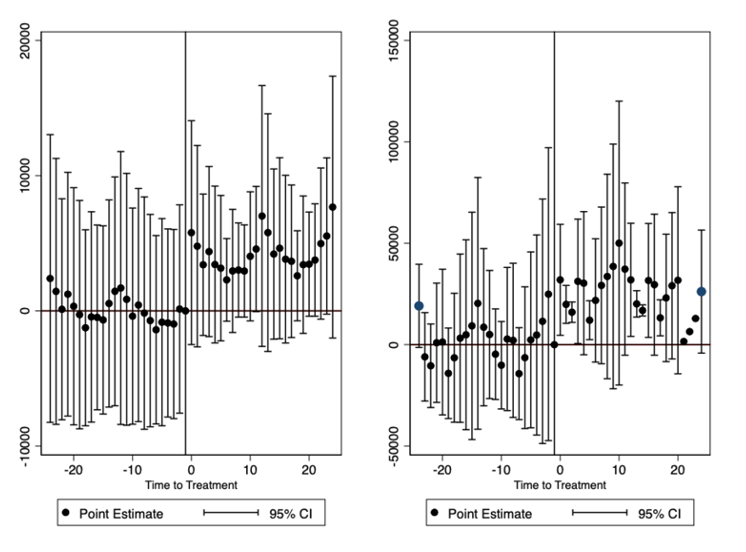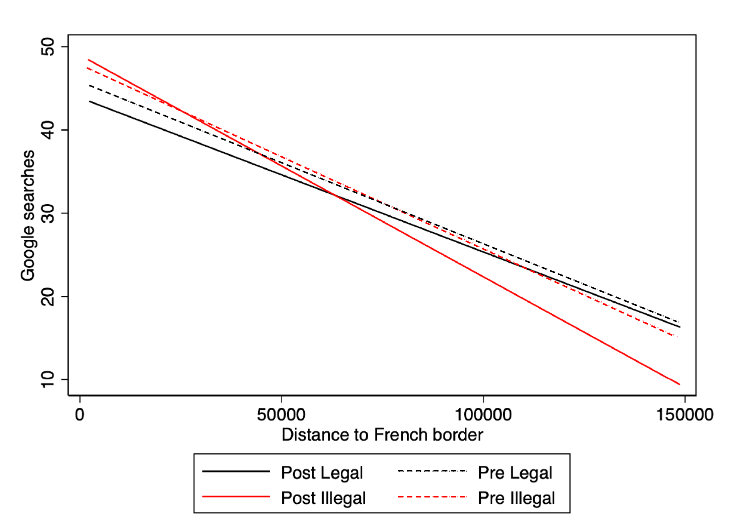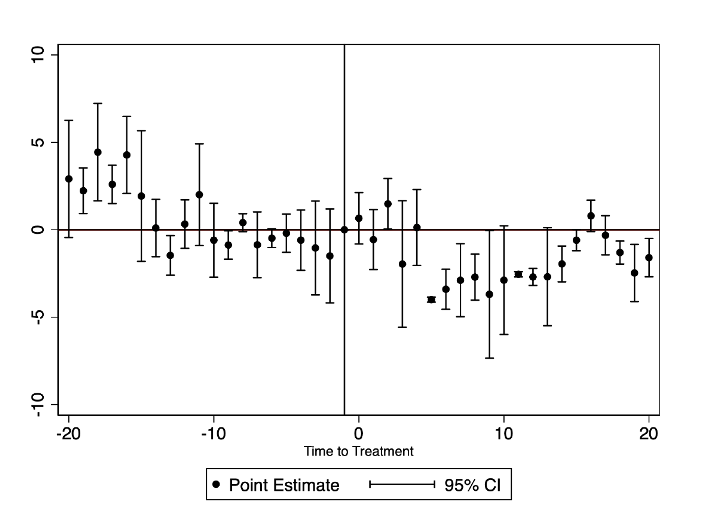Spillover effects from the nordic model of prostitution legislation
In recent years several European countries alongside Canada and Israel have adopted the so-called Nordic model of prostitution legislation to try and reduce the risk of sexual exploitation. While the reforms directly affect the regulation of the domestic sex market, their effects may also spill over to other outcomes in nearby areas and internationally – for example affecting sex tourism flows. Making use of data on tourism flows and Google searches, a new study examines the causal effect from the implementation of the reform in four different countries on sex tourism in popular destinations. The findings indicate that domestic reforms increase sex tourism, calling for the design of policies to account also for these adverse effects.
Introduction
Since 1999, when Sweden introduced the so-called Nordic model of prostitution legislation, similar legislation has been introduced in Canada, Iceland, Ireland, France, Norway, and most recently Israel. While the legislation design differs between countries (for an overview see Perrotta Berlin and Spagnolo, 2019), the common foundation is to effectively criminalize the purchase but not the selling of sexual services. The introduction of such reforms aims at battling human trafficking and reducing the risk of exploitation. While the effect from the asymmetric prostitution legislation has been found to increase rape incidence in Sweden (Ciacci, 2018), when it comes to the sex market the Nordic model is mainly thought to affect it in two contrasting ways. Firstly, it may suppress domestic supply, which could result in people travelling to destinations where prostitution is not criminalized. Secondly, it might affect the general view on prostitution (Kotsadam and Jakobsson, 2011), thus reducing domestic demand as well as international sex tourism.
Sex tourism is associated with human trafficking, child exploitation and increased spread of sexually transmitted diseases (Herold and Van Kerkwijk, 1992; Brooks and Heaslip, 2019; Newman et al. 2011). Despite this, few studies have explored the impact of prostitution laws on the practice – in part due to measurement difficulties.
This brief presents evidence from a forthcoming paper by Perrotta Berlin and Latour on sex tourism patterns following the implementation of the reform in four different countries.
Quantifying sex tourism
Perrotta Berlin and Latour use tourism patterns and Google searches to quantify sex tourism flows, in order to evaluate the effect from changes in prostitution legislation in Canada, France, Ireland and Norway. Specifically, they use data on the number of monthly tourist arrivals to Thailand and The Philippines, and weekly Google searches originating from the above-mentioned reform countries for popular sex-tourism and other tourism destinations, including attractions within cities. German tourism data and Google searches originating from France as well as Google searches originating in the US are used to estimate the effect on sex tourism to bordering countries (France to Germany and US to Canada, respectively). To evaluate the respective effects, they identify treated and control groups for each considered setting, and proceed to compare data between these groups before and after the reform (in line with the so-called difference-in-differences specification, as pioneered by Card and Krueger, 1994). In the following sections, each of these specifications and the subsequent results are discussed.
Evident spillover effects
Thailand and the Philippines
For Thailand and The Philippines, monthly data was available on tourist arrivals differentiated by country of origin from 2013 to 2020 and from 2008 to 2020, respectively. The underlying assumption is that, absent a prostitution legislation reform in the four considered countries (Canada, Ireland, France and Norway), the tourism flows from the country in question to Thailand and The Philippines would have remained the same over time. Thus, the change in the number of tourist inflow (out of which an unknown number are sex tourists) from the country in question – when compared to the number of tourists from other countries used as the control group – can be interpreted as a causal effect from the legislative reform on sex tourism.
The results show that, when compared to tourists arriving from other countries, the number of tourists arriving from one of the countries having recently implemented the Nordic model increased by 0.312 and 0.158 standard deviation points for The Philippines and Thailand respectively. Figure 1 below illustrates the results from an event study specification, in which the reform dates in the four different countries are aligned at 0, depicting how the increase is spread over the two years following the reform.
Figure 1. Number of tourists before and after the reform, The Philippines to the left and Thailand to the right.

(Notes: The horizontal axis is the time variable. Time is normalized such that 0 is the month when the reform came into force. On the left panel the vertical axis is the number of tourist arrivals to The Philippines from reform countries in deviation from control countries. On the right panel the vertical axis is the number of tourist arrivals to Thailand from reform countries in deviation from control countries.)
France-Germany border
In Germany, the legislative status of prostitution is determined at the level of municipality. For the analysis, German municipalities where prostitution is to some extent legal were considered to form the treatment group and municipalities where it is illegal constituted the control group. The outcomes of interest were i) tourists travelling to German municipalities of interest, and ii) Google searches from France for the same municipalities.
The analysis shows an increase in foreign tourism to the treatment municipalities following the implementation of the Nordic model of prostitution legislation in France. At the same time, no changes in domestic tourism was detected. The conclusion that the increase in foreign tourism is driven by an increase in French tourists, by which one could then argue the implemented reform to increase cross-border sex tourism, was validated by the analysis of French Google searches. In these data it can be seen that distant German municipalities where prostitution is legal become relatively more interesting in French Google searches after the reform compared to municipalities where prostitution is illegal.
Figure 2. Searches of German municipalities originated in France relative their distance from the French border.

(Notes: The vertical axis is the weekly index of Google Trends for searches for municipalities in Germany originated in France. The horizontal axis is distance from the French border. The red line shows that the slope decreased, i.e. distance became more salient for municipalities with illegal prostitution after the reform.)
Canada-US border
Data on Google searches for Canadian municipalities from one year before to one year after the reform in Canada were considered for the analysis. Searches originate in different US states, which also differ in the extent to which purchase of sexual services is legally punishable. The length of imprisonment in each US state determines whether a state was considered treated – when the length of imprisonment equals or exceeds that in Canada following the reform – or control. Results show that after the introduction of the Canadian reform, Google searches for Canadian municipalities dropped, in particular, in US states with high punishments for purchase of sexual services – most likely those where sex tourism to Canada used to originate before the reform. The results from the event study is depicted in Figure 3 below.
Figure 3. Number of searches of Canadian cities before and after the reform, deseasoned.

(Notes: The horizontal axis is the time variable. Time is normalized such that 0 is the month when the reform came into force. The vertical axis is the number of searches from US states with high punishments in deviation from control states.)
Sex tourism destinations
Finally, Google Searches for sex tourism destinations were considered as the outcome variable with the underlying idea being that – in the absence of a legislative change in the four considered countries – the difference in number of searches for sex tourism vs tourism destinations would have been the same over time. Sex tourism destinations were defined in two alternative ways: first, a list of popular destinations was selected within countries where prostitution is legal; second, this list was augmented with information from websites that list popular destinations for sex tourism, regardless of the legal status of prostitution in that country.
The results from this analysis are less clear, varying with the definition of sex tourism destinations and with the country of origin. But by and large they showed, if anything, that the interest in sex tourism destination countries decreased after the reform. This might indicate a change in attitudes towards lower acceptance of sex trade in general in the countries where the reform was implemented.
Conclusion
Prostitution legislation reforms affect the domestic sex market and have potential cross-border and international spillover effects. One such impact from criminalizing the purchase of sexual services domestically is increased levels of sex tourism, which might in turn impose adverse effects on the destination countries.
Filling a research gap by studying the effect from introducing asymmetric prostitution laws on sex tourism, Perrotta Berlin and Latour find evidence suggesting that harsher domestic regulation, while potentially changing attitudes in the general population (as indicated by Google Searches) also, in specific cases, increases, the outflow of tourists to destinations with less stringent laws.
After the introduction of the Nordic model, Norway has imposed legislation prohibiting their citizens to purchase sexual services even in countries where it is legal and implemented awareness campaigns on the detrimental effects of sex tourism on local populations. Given that sex tourism is associated with human trafficking, child exploitation and increased spread of sexually transmitted diseases, the results call for other countries to follow suit with domestic prostitution legislation taking on a more global approach to achieve greater effectiveness.
References
Disclaimer: Opinions expressed in events, policy briefs, working papers and other publications are those of the authors and/or speakers; they do not necessarily reflect those of SITE, the FREE Network and its research institutes.
Photo: Gideon Ikigai, Shutterstock




